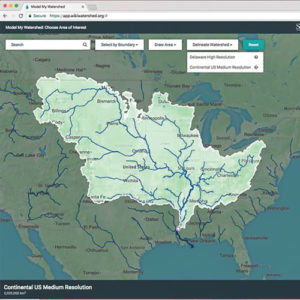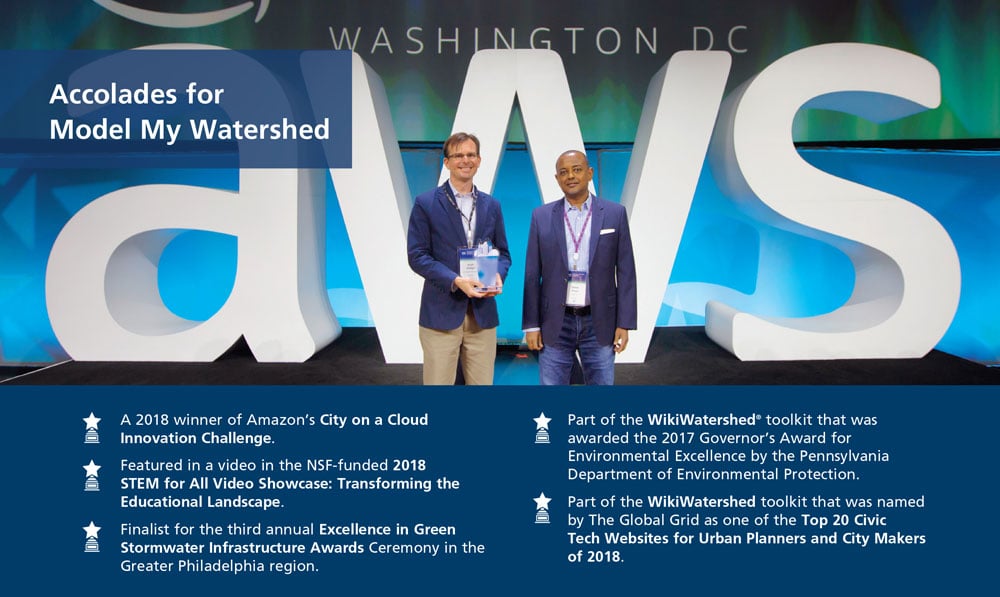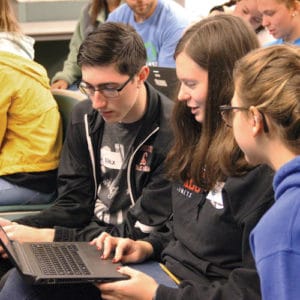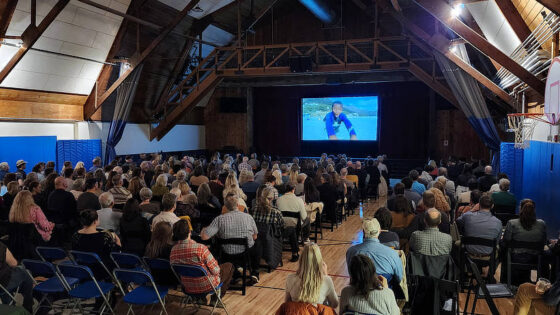
Photo courtesy of the Pennsylvania Department of Conservation and Natural Resources
The Digital Learning Tool Flooding Classrooms Coast-to-Coast
By Mandy Nix
The energy in the room is electric as fingers skitter across keyboards and eyes run marathons over laptop screens. From the edges of chrome-and-plastic school chairs, students traverse hundreds of stream miles in a few mouse clicks, chasing their schoolyard creek in southeastern Pennsylvania past George Washington’s famed crossing of the Delaware River in Trenton, New Jersey, and winding over the New York–Pennsylvania line to a headwater stream in the Catskills. Air conditioning buzzes overhead while students build cities, plant forests, install rain gardens, and try their hands at no-till agriculture. They make it rain, discover connections between land use and water quality, and model the watersheds of today for the stewardship of tomorrow.
This is Model My Watershed®, a professional-grade watershed modeling web app that enables students, citizens, and scientists alike to analyze real data and model water-quality impacts in watersheds across the lower 48 states. Stroud Water Research Center developed the tool in collaboration with LimnoTech, Penn State University, Utah State University, Drexel University, the University of Washington, Azavea, and Meliora Design.
“Model My Watershed puts at people’s fingertips a quick, preliminary analysis of what’s in their watershed and what human decisions and landscape features may be important for water quality,” says David Arscott, Ph.D., director of the Stroud Center and a key player in the web app’s inception in 2009. “For anyone interested in learning anything about their stream, the very first place they should go is ModelMyWatershed.org.”
 James Hovan, a 10th through 12th grade biology teacher in Lancaster, Pennsylvania, says, “Model My Watershed allows students to quantify what sustainability looks like using real data to make compelling arguments for certain conservation practices in certain areas.” He has used the tool to illustrate water-quality impacts and best management practices since 2015. “It is amazing to see how much more invested students become in these projects knowing that they are using real-world data to help solve real-world problems.”
James Hovan, a 10th through 12th grade biology teacher in Lancaster, Pennsylvania, says, “Model My Watershed allows students to quantify what sustainability looks like using real data to make compelling arguments for certain conservation practices in certain areas.” He has used the tool to illustrate water-quality impacts and best management practices since 2015. “It is amazing to see how much more invested students become in these projects knowing that they are using real-world data to help solve real-world problems.”
Hovan implements a place-based, problem-based watershed curriculum from the Teaching Environmental Sustainability: Model My Watershed project, a Stroud Center collaboration with Millersville University and Concord Consortium funded by the National Science Foundation. While actively engaging middle and high school students in watershed modeling and hands-on activities, the interdisciplinary curriculum promotes watershed stewardship, geospatial literacy, and systems thinking in science, technology, engineering, and mathematics (STEM).

Photo: James Berglie
More than 1,800 miles away in Gypsum, Colorado, STEM teacher Katie Lunde uses the curriculum to help her sixth- and seventh-graders critically analyze and understand the many environmental, economic, and social problems surrounding water.
“I don’t think my students would typically walk around their schoolyard and think about soil, land cover, or conservation practices, or consider the impact of different types of pollution on the water near their own homes,” confesses Lunde. “But this curriculum is an eye-opening experience that engages kids in a global issue — clean water. It makes them think, ‘Wow, we have the same issues here in Eagle County as kids in India and around the world. We all have pollution. And we all need clean water.’”
Since 2016, 117 middle and high school teachers like Hovan and Lunde in eight states have completed training and classroom implementation of the curriculum. Hovan and Lunde shine among them as Model My Watershed Master Teachers, a coast-to-coast collective of 23 exceptional educators who lead the pack in implementing Model My Watershed in their own classrooms and spreading its delivery to others around the country.
Visitors to the online curriculum portal from 26 different states in 2018 indicate that its reach is only growing. Teachers are hungry for quality digital tools that support three-dimensional learning in the classroom while being free, fast, easy to access, and easy to use — boxes all ticked by the Stroud Center’s cutting-edge web app.
Transporting Stewardship From the Screen to the Field
Perhaps the true power of Model My Watershed is not contained in a computer screen, but in the lasting lessons of action-based stewardship that follow students into the field. “Part of the original vision for Model My Watershed was to empower people not just to learn about their backyard, but to have the tools to understand problems and figure out how to fix them,” recalls Arscott. “Now, we are eager to know, Has this tool led to action for anyone out there?”
Student action is a priority for Master Teachers hoping to equip students with the skills to analyze and solve complex environmental issues — from floods to drought. In the rolling farmlands of southern Pennsylvania, Hovan and his students are experiencing historically heavy rainfall and aberrations in the water cycle that he describes as “the new normal” in a state affected by climate change. “In the field, we have noticed much more riparian damage and channel shifting along the small streams we study than in previous years,” says Hovan. “Since Lancaster County is the land of legacy sediment, this likely translates to much more sediment being transported downstream.”

Photo courtesy of the Pennsylvania Department of Conservation and Natural Resources
Model My Watershed’s Site Storm Model has allowed Hovan’s students to simulate large rain events that reflect current extremes in their watershed and discover best management practices that “effectively guard humans and the natural world from deluge and drought.”
Meanwhile, in Colorado streams twisting below evergreen forest and chalk-white gypsum cliffs, Lunde’s students have experienced shrinking snowpacks and extensive drought. “The last few seasons in Gypsum, we had absolutely no snow and hardly any precipitation,” says Lunde of record drought in the state hailed the Mountain of Rivers. While 2019 has brought more precipitation to the region, the 2017–2018 water year in Colorado was the warmest and second driest in over 120 years of climate data. “Our rivers really ran dry, the waters were warm, and we observed a decline in macroinvertebrate and fish populations.”
Lunde embraces the weather extremes as teachable moments on the impacts of climate and human decisions on watershed health. Each year, her students become junior stream scientists while collaborating with their upstream neighbors in the ski town of Vail, where they collect and analyze aquatic macroinvertebrate and water chemistry data in Gore Creek and, more recently, plant native trees to restore streamside forests. At the least, the web app’s curriculum is inspiring problem-solving, critical-thinking, and global-ready skills in her students, but at the most, it is jumpstarting their exposure and enthusiasm with STEM-related careers. “I have students who are aspiring for careers that they know, but I want them to be engaged in and aspire for careers they never knew anything about,” said Lunde. “We need those global thinkers, those specialized careers in STEM and sustainability, and Model My Watershed is opening those doors for my students.”
With impacts stretching 3,000 miles in classrooms coast-to-coast, the video gamelike interface of Model My Watershed is not an alternative to boots-in-the-water education; it is an enhancement and a revolution to the way we teach, understand, and conserve watersheds.
“I would encourage anyone who wishes to impress the ecological, social, cultural, and economic value of a watershed on their students to give Model My Watershed a try,” urges Hovan. “They will not be disappointed.”
This article was originally published in Stroud Water Research Center’s 2018 annual report.
Endnote
Teaching Environmental Sustainability: Model My Watershed is funded by the National Science Foundation (grant DRL-1418133). The principal investigators are Steve Kerlin, Ph.D. (Stroud Center), Nanette Marcum-Dietrich, Ph.D. (Millersville University), and Carolyn Staudt (Concord Consortium). WikiWatershed® and Model My Watershed were funded in part by:
- National Science Foundation (grants DRL-1418133, DRL-1417527, DRL-1417722, DRL-0929763, and DRL1433761)
- William Penn Foundation (grants 103-14 and 12-17)
- Stroud Water Research Center
- Virginia Wellington Cabot Foundation
- The Dansko Foundation
- Generous donations from Peter Kjellerup and Mandy Cabot



